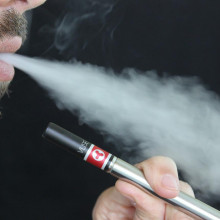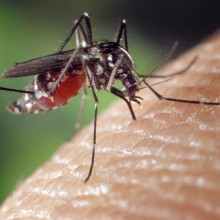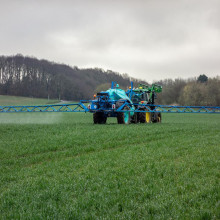Are public health officials preparing to clampdown on the sale of dangerous vapes? How scientists are cracking why some of us are magnets for mosquitoes, and a very welcome floral addition to King’s College, Cambridge.
In this episode

00:47 - Vapes contain toxic levels of heavy metals
Vapes contain toxic levels of heavy metals
Linda Bauld, University of Edinburgh
There are growing calls to clamp down on the underage sale and branding of e-cigarettes. A BBC investigation found that vapes confiscated from school pupils contained dangerously high levels of lead, nickel and chromium. Health officials are concerned. Linda Bauld is a leading public health expert and a social policy advisor to the Scottish government.
Linda - It's not terribly surprising to me because we always know with age-restricted products you're going to have an illicit trade. And when you have an illicit market you can have constituents in the products which can be harmful. The three things that have been identified in the lab. So lead obviously has a detrimental effect on the brain. That's why we've banned lead in pipes and lead in petrol. In relation to nickel and chromium as well, those are class A carcinogens. And nickel, we know in particular, the effects on lung health can be serious. And then chromium of course can be used in small amounts, trace amounts as a supplement for people with diabetes and pre-diabetes. But at the higher levels they've found here. We also know there are effects on the liver and a number of potential health harms. So I think an acute exposure to the levels they've identified in the lab is probably not going to cause irreparable harm to young people, but chronic exposures would do and that's a worry. So cracking down on illicit trade is a priority.
Chris - We seem to be in a difficult position with this, don't we? Because on the one hand we've got positive health messaging around vaping. This is much better for you in terms of health threats than smoking. But on the other hand, it's being pushed at youngsters to addict to the next generation of people who might have smoked, but instead they're turning into vapers.
Linda - Yes, and we always knew this was a risk. I mean, we've been monitoring youth vaping from the beginning of the products being rolled out and we were surprised that we didn't see a rise in youth vaping over the years because the US and others had expressed more concern about it. There was quite a bit of experimentation, but regular use was not going up. But then we saw this big shift really during the pandemic period and with the new advent of these disposable devices, which are used by 69% of young people aged 11 to 17 compared to 7% in 2021, they've clearly driven a big uptick. And the reasons for that are that they're cheap. The main disposables were about £2.99. You can get them for even cheaper. They're really bright. There's loads of flavours. They're marketed at the point of sale because we've removed the tobacco displays. So vaping products are very visible and they're also discreet. So what we've seen is this rise. The rise in young people who've used vaping once or twice is now up to 11.6%. That was 7% just in 2022. Current use, so people who say they're vaping at the moment, jumped up to about 8% last year and it sort of stayed at that level and that was a rise from the year before.
Chris - We seem to be very slow off the mark on this though, because I was having a look at what other countries are doing because other countries have also experienced a big increase like we have. You mentioned America earlier, I know Australia have, New Zealand have seen a tripling in the number of kids who vape in recent years. Their regulations and legislations appear to be far more stringent than ours though. Even in China where many of these products are made and then shipped here for our kids to consume, they're completely illegal there. So why are we so slow to react?
Linda - It's actually not that we've been slow, it's that we had a different paradigm. So most of these countries have a fear of nicotine. They don't prescribe nicotine replacement therapy to pregnant women, to people with coronary heart disease, to young people. If you know, you can get NRT on prescription if you're age 12 or above in the UK. The priority is to get adult smokers to quit because we had the highest rates of smoking back in the fifties and sixties and it's taken us decades to get down to lower levels. The priority is the smokers. We thought that other countries were panicking about the youth and imposed too stringent measures. But now the chickens have come home to roost. We're now faced with a rise in youth. So I think the policy approach that we took, which was to prioritize harm reduction and smoking cessation, we're now going to need to shift.
Chris - The genie is really well and truly out of the bottle, isn't it? Can we get it back in though? What can we do now so that these very significant numbers of young people who, many of them openly admit that they are consumers of nicotine because they're addicted. What can we do now to try to stop this getting any worse?
Linda - I'm confident we can put the genie back in the bottle because we did it with tobacco. So we need to apply the same regulatory tools and basically you impose policy so you could do the extreme and you could ban this category of products, disposable vapes, also on environmental grounds. They're thrown in the street, they're hugely damaging to the environment, incredibly difficult to recycle. Or you could be a little more subtle and say, okay, what we're going to do is we're going to increase the price. Increasing prices is a big driver for young people not to buy a product. But then you'd also need measures for the illicit trade because that can be an unintended consequence. You can do things about point of sales, not making them as visible or accessible in shops. You can also take action on the labeling, the packaging, the colours, the flavours, the four P's. I always go back to - product, place, price and promotion.

06:20 - Russian scientists on trial for treason
Russian scientists on trial for treason
Mark Galeotti, UCL
The seventy-six year-old Russian scientist, Anatoly Maslov, is to stand trial for treason over claims that he and two of his colleagues betrayed state secrets. The arrest of the three hypersonic missile experts has spooked the country’s scientific community, which has warned that prosecuting them sets a dangerous precedent and risks damaging Russian research. It comes as the war between Russia and Ukraine continues to rage, with Moscow anticipating a huge counter-offensive by Kyiv’s army. Mark Galeotti is an honorary professor at UCL and the author of Putin’s Wars: from Chechnya to Ukraine.
Mark - There are three essentially hypersonic and aerodynamic specialists from the Khristianovich Institute of Theoretical and Applied Mechanics in Novosibirsk Siberia. And the allegation is that at a conference in 2017, they passed classified information to Chinese scientists. And as a result of this, they are currently on trial for treason, which faces a life sentence if they're actually found convicted. The point is though, this is also just part of a trend. I mean, we've now had fully 16 members just to the Siberian branch of the Academy of Sciences who have been arrested by the FSB, the Federal Security Service, of late. So there clearly is a much wider crackdown going on.
Chris - The way that science is conducted, though, internationally is that scientists will go to other countries, they will share information, they will exchange ideas. Even in World War II we had physicists collaborating and writing between Germany, America, the UK for example, because science was going on despite war. That's how we do science. It's called peer review. So is there a sort of blurring of the boundaries here between what they're doing as legitimate science and what they're doing in terms of giving away state secrets and is that the bone of contention?
Mark - Really what this is, is a clash between two cultures. You have the scientific culture which in Russia, absolutely as everywhere else, is not just interested in peer review and cooperation, but precisely also does so on an international basis. And you travel to the conferences, you read the papers, you write the papers because you want to learn as well as share. And then you have the culture of the increasingly powerful security operators, particularly the FSB, which is firstly unaware really of how science works and doesn't really care either. Secondly, is gripped by a particular mood of paranoia these days. And thirdly is also increasingly worried about what's meant to be Russia's great ally - China. Because we've seen a lot of espionage related cases involving China of late. And so I think they've now come to the stage where everybody who has any real contact with the Chinese is a potential traitor.
Chris - And what have been the repercussions, ramifications, and reactions from the scientific community in Russia?
Mark - Well, interestingly, again, we are told often that basically the Russian people are downtrodden and submissive to the state. But what's striking is actually the degree to which, at the moment, the scientists are standing up. They're writing open letters, they're petitioning local and national officials to try and not only get Maslov and his co-defendants freed, but also just trying to push back against this increasing tide of prosecutions of scientists for doing science. So, although it's not exactly the sort of thing which is going to bring crowds out onto the streets, but nonetheless, it is striking that the intellectual and scientific elite of Russia are doing what they can to highlight these cases and push back.
Chris - And is the regime receptive?
Mark - Well, look, on the one hand the answer is obviously it needs the output of these scientists. Putin has made much after all of Russia's leading edge weapons technology, including hypersonics. And that all requires a good solid scientific base to get anywhere. But at the same time, unfortunately the impact of the war in Ukraine, the sanctions, and the general sort of alienation of Russia from the rest of the world means that at the moment, security operators are very much in the ascendant. So, I mean, what I'm hearing, frankly, from people I know in Russia is that yes, they'll protest, they don't actually expect to have great impact and to a degree they're hunkering down and they're doing what they need to do to survive in this new era.
Chris - And just very briefly, Mark, do we read anything into this about the war effort?
Mark - Not so much the war effort because, in some ways, the gap between the theoretical and even applied science and actually the production of finished weapons is such that in the current and just over the horizon weapons were really designed 10 plus years ago. It's more about how the war is changing the culture of Russia. That is the real impact here.

12:09 - Why mosquitoes prefer some people to others
Why mosquitoes prefer some people to others
Conor McMeniman, Johns Hopkins University
Scientists think they may have found out why mosquitoes bite some people - but leave others alone. Apparently, it’s all about the type of chemicals that are excreted by our bodies. The discovery was made by scientists at Johns Hopkins University, who built a large open-air arena in Zambia as part of their study. The architect of the project is Conor McMeniman.
Conor - We were really excited to develop a new system to decode what molecules emitted in our skin, odour, and breath are very attractive or perhaps not so attractive to the mosquito that transmits malaria throughout Africa.
Chris - I thought this had been looked at in some detail in decades past. Experiments where people were put in bubbles and all the smells that come off them were taken away and then presented to hungry mosquitoes to see what they did.
Conor - Yeah. There's been a wide range of studies conducted over the past hundred years or so. Most of these have been performed actually at small scales in the laboratory and in this study we built something much, much larger in a malaria endemic region of Africa in Zambia.
Chris - So this is real world data. It's the mosquitoes and the people that would normally interact.
Conor - Yeah. So to do this, we actually built an assay 2000 times larger than existing laboratory assays. This is about the size if we think about the area of two center courts in a tennis arena, basically a massive greenhouse facility. The arena itself is actually exposed to the elements, so wind currents can flow for this arena. The mosquitoes which we place inside are actually exposed to natural fluctuations in temperature and also humidity. And the foresight of this massive greenhouse, we have positioned 15 metres away, one person tents. And in these tents we can actually place individual humans. We actually connect these one person tents to the greenhouse by air conditioning ducting. Humans who occupy the tents fill the atmosphere of that tent with all of their scent, this rich bouquet of around 300 different chemicals that are released from the skin and the breath into the air. And then once it gets into the field cage, we have hot plates warm to human skin temperature. And on top of the hot plate is actually an infrared camera, which monitors the landing of mosquitoes on this hot plate. The scent from those tents is actually wafted over the surface of this hot plate, mimicking human skin. We simply then record throughout the nighttime period how many mosquitoes land on these hot plates. And each of these tents will have individual humans. We can compete up to six humans' scent profiles against each other all at once.
Chris - And are you taking snapshots of what those smells are coming from each of the individual humans? So you've got samples you can then analyse?
Conor - Yeah, that's exactly what we did. So concurrently we also actually sample the air from that ducting path to gain a snapshot of what chemicals are being emitted in the scent signature of that individual. And we can quantify the number of mosquitoes that really love that scent or dislike that scent by recording the number of landings. By analyzing that chemical sample, we can actually discern what the chemical constitution of the human scent signature is that actually is associated with being highly attractive or not so attractive at all.
Chris - Are there push pull factors here? Are some people just really attractive to mosquitoes, others less so? Or are there people at the other end of the spectrum that are actively repugnant, at least in small terms, to a mosquito?
Conor - Right. During the initial validation of this system, we were really excited to see that, night after night, we found individuals that were highly attractive to mosquitoes. In particular, we found one individual that was a mosquito magnet. On the other end of the spectrum, we found an individual that really had a radically different scent signature to the other humans. And this individual wasn't very frequently targeted by mosquitoes.
Chris - What about the fact that we know that certain human conditions may also predispose people to being more attractive to mosquitoes? Malaria itself might do that. Pregnancy also allegedly does this.
Conor - The comparative power of this system, the ability to test larger groups of humans all at the same time, will really allow us to start to test some of these anecdotes and also observations from scientific data from the field that has been previously observed. It's really worth noting that pregnant women are at a high risk of sickness from infection with malaria. So that would be a really important one to test. Also, whether your blood type correlates with how attractive you are to mosquitoes or other sort of anecdotes that get thrown around, for instance, my blood is sweeter than another person's and therefore I'm more attractive to mosquitoes. We can actually now test whether the blood of individuals that seem to be more highly attractive might have higher levels of sugars or other metabolites in their blood.
Chris - And presumably it's an opportunity to test novel ways to repel mosquitoes as well.
Conor - Yeah, absolutely. I think this system has the potential to reveal new components of human scent that might be produced by the human body naturally or alternatively acquired in our diet, for instance, that might make us less attractive to mosquitoes. By identifying what those molecules are, perhaps we could find ways to add them to existing repellent formulations that we currently apply to our skin and buy from the shops that could enhance the activity and efficacy of those particular products. So I think this system also provides a really great way to test repellants and benchmark their activity and efficacy in an exposure free and risk free way for humans. Everyone hates being bitten by mosquitoes.

18:45 - King's College lawn becomes wildflower meadow
King's College lawn becomes wildflower meadow
Steven Coghill & Cicely Marshall, King's College Cambridge
The gardeners at King’s College, Cambridge have broken with hundreds of years of tradition by deciding not to cut the site’s fabled lawn - which backs onto the River Cam. Over the past four years, a wildflower meadow has sprung up in its place and biodiversity there is thriving.
Will - I won't lie, I leapt at the opportunity to visit King's College and its wildflower meadow. And even from a distance here, it looks absolutely stunning with the yellows and reds and greens. But let's go down now and find out who's going to be taking us through the garden.
Steve - Hello, Hello. Yes. My name's Steve Coghill. I'm the head gardener at King's College Cambridge. And part of my responsibility has been to see the development and the flowering of this amazing wildflower meadow that we're standing in front of at the moment.
Will - Historically, the front of King's College, Cambridge here has been, dare I say it, fairly uniform, flat, and green for the most part. Certainly as I've ever seen it. That's not the case now.
Steve - Absolutely. As we sort of trundle through into the 21st century, there are other things that we need to look at. You know, we need to look at putting back more into nature, and that is part of this meadow that here we are right in the heart of Cambridge, and yet we have this amazing meadow that actually means so much to so many people over the last few years.
Will - Yeah. Do you want to just sort of walk and talk us through it, what we are looking at here?
Steve - Okay. Yeah. Well, the meadow itself, this is basically what you call a Lammas meadow because we cut it during Lammas time, which is the first week of August. And here we can see we have buttercups, we have ox eye daisies, we have Silene dioica, the red campions, coming through. We can see that the vernal layer of cowslips is already fading away and they'll be seeding back into the ground. If you have a look around the outskirts, you'll see that we've also got some poppies coming along and cornflower and corn chrysanthemum and a whole raft of native grasses that make up this amazing matrix.
Will - And I'm sure we're about to cover the scientific side of what this all means, but just from your own perspective, this looks great. It invokes a great sensation just to be here amongst it.
Steve - Wellbeing is a massively important thing, and meadows are wonderful because they have the wildlife component, they have the floral component, which is wonderful. You have the wind moving over the meadow, which when the meadow gets higher, you can hear that wonderful susurration as the wind moves over it. And then we cut a path through and then it's just great watching kiddies run through it. Sort of wiping their hands along, you know, stroking the plants as they go.
Will - Like Gladiator.
Steve - It is, it is honestly just like Gladiator but without the blood. So that's quite good.
Will - <laugh> a take home message for us all there.
Steve - I think so, yeah.
Will - We should probably move on to the science before that conversation devolves even further. And who better than the project's own Cecily Marshall…
Cecily - In terms of numbers of species, we found roughly three times as many species of plants and spiders and bugs. And we even found that bats are recorded three times as often over the meadow than over the lawn. We also have changes in the species composition. So the type of species that are using the meadow compared with the lawn. We are seeing grassland specialist species in the meadow now. So species that are rarer or declining, species that are characteristic of our traditional meadows. They're not species we've planted. They're species that just have arrived themselves, which is really rewarding to see.
Will - And perhaps we shouldn't expect too much from a fairly modest sized patch of lawn, but were there any effects on the carbon mitigation side of things?
Cecily - What we did find was reduced emissions from mowing and fertilising associated with a wildflower meadow compared with a lawn. So a fine lawn like ours at King's is conventionally managed by a regular regime of watering and also fertilising and some weed killer. So we have much lower emissions associated with managing the meadow. And that's good news. <laugh> for climate change mitigation.
Will - Did you see any effect on the temperature, because we talk a lot about heat islands and how trees are important in cities because they help lower the overall temperature in urban environments. Was that the case here as well?
Cecily - Actually what we found was that the wildflower meadows are more reflective than the remaining lawn is. Yeah. Which is probably a small effect, but it's associated with a reduced urban heat island effect rather than trapping it and holding it at ground level.
Will - Thanks to Cecily for that. And I would be remiss if I didn't ask Steven just how you could create a wildflower meadow of your own at home.
Steve - You can have a wildflower meadow in your own garden, no problem at all. The first tip is to if you've got a lawn, are there areas of the lawn that you can just stop mowing? Because if you do, then you might see all sorts of interesting things coming up through the lawn that you never knew you had. Then if you want to destroy your lawn in order to grow a little wildflower meadow you can use plug plants. Little plug plants in little containers that you can then sort of plant into an area of lawn that you've set aside and that will allow you to establish a meadow without wholesale destruction to start with. And then of course you can actually dig an area up, cultivate it, and then sow one of the many different wildflower seed mixes that there are available out there because you know it's best to have local seed, seed from plants that are growing in your region or your area or indeed in your county because you know that they're going to look right and they also know that they got the characteristics that you need to grow as well. It's very important.
Will - So there you are, science in your own backyard. Thanks to everyone for hosting me. It was a great privilege to see this in action and I speak for all of us when I say we're very excited to see what's next.

24:43 - Can biofertilisers replace chemical fertilisers?
Can biofertilisers replace chemical fertilisers?
The University of Cambridge's Giles Oldroyd helped James Tytko with this question from listener Douglas...
James - A very pressing question, Douglas, given the news we are to reach the Paris Agreement’s 1.5 degree temperature target in just 7 years and the contribution of synthetic fertilisers to the degradation of our environment. One University of Cambridge study found that, along with manure, fertilisers emit the equivalent of 2.6 gigatonnes of carbon per year - that’s more than the shipping and aviation industry combined! With me to explain the role biofertilisers might play in bringing this down is Giles Oldroyd from the Department of Plant Sciences at the University of Cambridge.
Giles - Hi James. Not only would replacing chemical fertilisers with biofertilisers greatly reduce the greenhouse gas emissions and pollution derived from agriculture, it would also be cheaper for farmers to practice! Most fertilisers are nitrogenous - they contain nitrogen - and a lot of energy is required to generate them. Most of this energy is derived from natural gas, making fertilisers costly, especially now with the higher costs of gas. As well as extensive greenhouse gas emissions, the application of fertilisers causes a release of nutrients into the natural environment and depletes biodiversity.
James - Biofertilisers instead make use of the ability of fungi and bacteria to capture essential nutrients, especially nitrogen and phosphorus, from the surrounding soil and air. Some species of bacteria possess an enzyme capable of converting molecular dinitrogen in the air into ammonia, a reactive form of nitrogen that plants can use.
Giles - Some plants form associations with these nitrogen-fixing bacteria, as well as with some fungi that help the plant capture sources of nitrogen, phosphorus and water from the soil. Biofertilisers make use of these microbial associations, either directly with the target crop plants, or with co-cultivated plants that can form the associations.
James - The stumbling block to completely replacing inorganic fertilisers with biofertilisers is the levels of the nutrients one can currently deliver to crops using biofertilisers. But raising the utility of biofertilisers is an area of very active research in both public and private sectors.
Giles - Field trials are currently ongoing at the University of Cambridge looking at plants that get hypercolonised by the beneficial fungi, and a number of companies around the world are developing nitrogen-fixing bacteria to act as biofertilisers for cereal crops.
James - So, Douglas. Yes indeed the use of biofertilisers is advantageous over chemical fertilsiers owing to their reduced burden on the environment. Some fungi and bacteria form associations with plants and give them the nitrogen they would otherwise be getting from chemicals which are carbon intensive to produce and apply. Biofertislisers aren’t currently as efficient as they could be, but there are promising developments in this highly active research field.










Comments
Add a comment